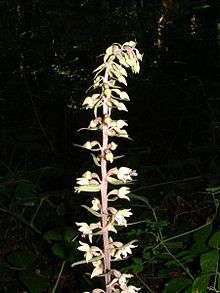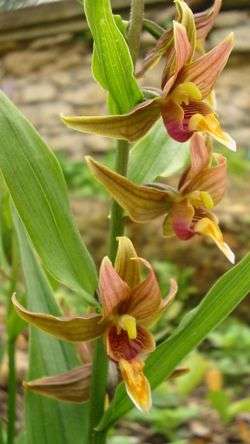Epipactis
| Epipactis | |
|---|---|
 | |
| Broad-leaved Helleborine (Epipactis helleborine) | |
| Scientific classification | |
| Kingdom: | Plantae |
| (unranked): | Angiosperms |
| (unranked): | Monocots |
| Order: | Asparagales |
| Family: | Orchidaceae |
| Subfamily: | Epidendroideae |
| Tribe: | Neottieae |
| Subtribe: | Limodorinae |
| Genus: | Epipactis Zinn 1757 |
| Species | |
|
See text. | |
Epipactis, or Helleborine, is a genus of terrestrial orchids consisting of approximately 70 species. This genus is abbreviated as Epcts in horticultural trade.
They occur in temperate and subtropical climates of America, Asia, and Europe. These orchids grow in open spaces in forests, in undergrowth, on calcareous soils and are often found in wet dune-slacks near the sea. The only original American species is Giant Helleborine (Epipactis gigantea). One species from Europe, Broad-leaved Helleborine (Epipactis helleborine), is invasive in North America. Most species are protected.

(Epipactis palustris)
Most of these hardy orchids grow in a wet environment, but there are exceptions. The Marsh helleborine (Epipactis palustris) is the only European orchid able to survive in a flooded habitat. Epipactis gigantea is a species found in the American west, and into southern Canada, in wet areas and even streams. It can grow to a height of 1 m. However, Epipactis helleborine grows in more diverse habitats, from sheltered sandy beaches to open spaces in deciduous or coniferous forests, on roadsides, in meadows, and on moist soils. It is sometimes called the Weed Orchid.
As characteristic of all orchids, Epipactis spp. are dependent on a mycorrhizal symbiosis (see also Orchid mycorrhiza). This allows some species to have reduced leaves and need little chlorophyll. Violet Helleborine (Epipactis viridiflora) can even do without chlorophyll. These forms can be recognized by their purple instead of violet flowers.
Their creeping, fleshy rhizomes grow offshoots, from which then emerge the 20–70 cm long stems during the next spring.
There are four to eight alternate, lanceolate leaves, that grow progressively shorter near the top. The margins are entire, the top is acute. Species with less chlorophyll have blue-purple leaves.
Their bilaterally symmetrical colorful flowers grow from a terminal raceme. The three sepals and the two lateral petals are ovate and acuminate. Their color can vary from greenish-white to violet and purple.
The lip is divided in a bowl-shaped hypochile, with the outer surface greenish-white and threaded with dark veins. The wavy, snow-white epichile is fan-shaped.
The ovary is inferior. It produces a dry capsule with countless minute seeds.
Species

- Epipactis africana (Ethiopia to Malawi).
- Epipactis albensis (C. Europe).
- Epipactis albensis var. albensis (EC. Europe). Rhizome geophyte
- Epipactis albensis var. fibri (France). Hemicryptophye or rhizome geophyte
- Epipactis aspromontana (Italy) - now synonym of Epipactis leptochila subsp. aspromontana (Bartolo, Pulv. & Robatsch) Kreutz
- Epipactis atromarginata (Vietnam).
- Epipactis atrorubens (Hoffm.) Besser : Dark Red Helleborine, Royal Helleborine (Europe to Caucasus).
- Epipactis atrorubens var. atrorubens
- Epipactis atrorubens var. atrata A.Waldner & Webernd (2005)(Austria).
- Epipactis atrorubens subsp. danubialis (Robatsch & Rydlo) Ciocârlan & R.Rösler
- Epipactis atrorubens subsp. spiridonovii (Devillers-Tersch. & Devillers) Kreutz
- Epipactis atrorubens subsp. subclausa (Robatsch) Kreutz
- Epipactis atrorubens var. triploidea (Gelbr. & G.Hamel) Kreutz
- Epipactis autumnalis D. Doro (Italy)
- Epipactis baumanniorum Ströhle
- Epipactis bithynica (Turkey) - now synonym of Epipactis helleborine subsp. bithynica (Robatsch) Kreutz
- Epipactis bugacensis (Hungary, near Bugacpusztaháza).
- Epipactis campeadorii (Spain).
- Epipactis cardina (Spain).
- Epipactis condensata (Turkey to Lebanon, Cyprus, W. Transcaucasus).
- Epipactis cretica (Crete).
- Epipactis danubialis (Romania) - now synonym of Epipactis atrorubens subsp. danubialis (Robatsch & Rydlo) Ciocârlan & R.Rösler
- Epipactis degenii (Greece) - now synonym of Epipactis halacsyi subsp. degenii (Szentp. & Mónus) Kreutz
- Epipactis distans Arvet-Touvet (Central Europe)
- Epipactis dunensis (Great Britain: N. England to N. Wales).
- Epipactis duriensis Bernardos, D.Tyteca (Portugal) - now synonym of Epipactis tremolsii var. duriensis (Bernardos, D.Tyteca, Revuelta & Amich) P.Delforge
- Epipactis exilis P.Delforge - now a synonym of Epipactis persica subsp. exilis (P.Delforge) Kreutz
- Epipactis flaminia (EC. Europe) - synonym of Epipactis greuteri var. flaminia (P.R.Savelli & Aless.) Kreutz
- Epipactis flava (Laos, Thailand).
- Epipactis futakii (EC. Europe) - now synonym of Epipactis leptochila var. futakii (Mered'a & Potek) P.Delforge

- Epipactis gigantea : Stream Orchid, Chatterbox, Giant Helleborine (W. Canada to N. Mexico).
- Epipactis greuteri H.Baumann & Künkele (Greece).
- Epipactis greuteri var. flaminia (P.R.Savelli & Aless.) Kreutz
- Epipactis greuteri var. preinensis (Seiser) P.Delforge
- Epipactis greuteri subsp. preinensis (Austria)
- Epipactis guegelii (Romania).
- Epipactis halacsyi Robatsch (Greece) - now basionym of Epipactis viridiflora subsp. halacsyi
- Epipactis halacsyi subsp. degenii (Szentp. & Mónus) Kreutz
- Epipactis helleborine (L.) Crantz : Broad-leaved Helleborine (N. Africa, Europe to C. China, Type species).
- Epipactis helleborine subsp. bithynica (Robatsch) Kreutz
- Epipactis helleborine subsp. helleborine (N. Africa, Europe to C. China).
- Epipactis helleborine subsp. latina (Italy to NW. Balkan Pen).
- Epipactis helleborine subsp. leutei (Robatsch) Kreutz
- Epipactis helleborine var. minor R.Engel (France)
- Epipactis helleborine subsp. molochina (P.Delforge) Kreutz
- Epipactis helleborine subsp. neerlandica (W. Europe).
- Epipactis helleborine subsp. orbicularis (C. Europe) synonym of Epipactis distans Arvet-Touvet
- Epipactis helleborine subsp. schubertiorum (Bartolo, Pulv. & Robatsch) Kreutz
- Epipactis helleborine subsp. transcaucasica (Caucasus). Hemicryptophye or rhizome geophyte
- Epipactis helleborine subsp. tremolsii (W. Medit.) Hemicryptophye or rhizome geophyte
- Epipactis helleborine var. youngiana (A.J.Richards & A.F.Porter) Kreutz
- Epipactis ioessa Bongiorni, De Vivo, Fori & Romolini (Italy)
- Epipactis kleinii (S. France to E. Spain)
- Epipactis komoricensis (EC. Europe) - now synonym of Epipactis leptochila subsp. komoricensis (Mered'a) Kreutz
- Epipactis lapidocampi E.Klein & Laminger (Austria)
- Epipactis latifolia All. nom. illeg. (synonym of Epipactis helleborine)
- Epipactis latifolia lus. rosea Erdner - now synonym of Epipactis viridiflora var. rosea (Erdner) Kreutz
- Epipactis leptochila (Godfery) Godfery : Narrow-lipped Helleborine (Europe).
- Epipactis leptochila subsp. aspromontana (Bartolo, Pulv. & Robatsch) Kreutz
- Epipactis leptochila var. cleistogama (C.Thomas) Kreutz
- Epipactis leptochila var. dinarica (S.Hertel & Riech.) P.Delforge
- Epipactis leptochila var. futakii (Mered'a & Potek) P.Delforge
- Epipactis leptochila subsp. komoricensis (Mered'a) Kreutz
- Epipactis leptochila subsp. leptochila (Europe).
- Epipactis leptochila subsp. maestrazgona (P.Delforge & Gévaudan) Kreutz
- Epipactis leptochila subsp. naousaensis (Robatsch) Kreutz
- Epipactis leptochila subsp. neglecta (WC. Europe). Hemicryptophyte or rhizome geophyte
- Epipactis leptochila var. peitzii (H.Neumann & Wucherpf.) P.Delforge
- Epipactis leptochila subsp. sancta (P.Delforge) Kreutz
- Epipactis leutei (Austria) - now synonym of Epipactis helleborine subsp. leutei (Robatsch) Kreutz
- Epipactis liestalensis (C. Europe).
- Epipactis lusitanica (S. and N. Portugal)- now synonym of Epipactis tremolsii subsp. lusitanica (D.Tyteca) Kreutz
- Epipactis maestrazgona P.Delforge & Gévaudan (Spain)
- Epipactis magnibracteata (NC. China).
- Epipactis mairei (Nepal to C. China)
- Epipactis mecsekensis (Hungary) - now a synonym of Epipactis nordeniorum subsp. mecsekensis (A.Molnár & Robatsch) Kreutz
- Epipactis meridionalis H.Baumann & R.Lorenz (Sicilia to S. Italy).
- Epipactis microphylla (Europe to Iran).
- Epipactis molochina P.Delforge (Spain)
- Epipactis moravica Batousek (Czech Republic, Slovakia, Hungary) - now a synonym of Epipactis nordeniorum subsp. moravica (Batousek) Kreutz
- Epipactis muelleri (W. & C. Europe).
- Epipactis muelleri subsp. cerritae (Sicilia).. Hemicryptophye or rhizome geophyte
- Epipactis muelleri subsp. muelleri (W. & C. Europe) Rhizome geophyte
- Epipactis nauosaensis (Greece) - now a synonym of Epipactis leptochila subsp. naousaensis (Robatsch) Kreutz
- Epipactis nordeniorum Robatsch (Austria)
- Epipactis nordeniorum subsp. mecsekensis (A.Molnár & Robatsch) Kreutz
- Epipactis nordeniorum subsp. moravica (Batousek) Kreutz
- Epipactis ohwii (C. Taiwan).
- Epipactis olympica (Greece).
- Epipactis palustris : Marsh Helleborine, Marsh Orchid (Europe to Caucasus and Mongolia)
- Epipactis papillosa (Russian Far East to Korea, Japan)
- Epipactis persica (Soó) Nannf. (SE. Europe to W. Pakistan)
- Epipactis persica subsp. exilis (P.Delforge) Kreutz
- Epipactis phyllanthes G.E.Sm. : Green-flowered Helleborine (W. & NW. Europe).
- Epipactis phyllanthes subsp. fageticola (C.E.Hermos.) Kreutz
- Epipactis phyllanthes var. olarionensis (France). Hemicryptophye or rhizome geophyte
- Epipactis phyllanthes var. phyllanthes (W. & NW. Europe)
- Epipactis placentina (Switzerland to Italy).
- Epipactis pollinensis (Italy) - now synonym of Epipactis viridiflora var. pollinensis (B.Baumann & H.Baumann) Kreutz
- Epipactis pontica (EC. Europe to N. Turkey).
- Epipactis provincialis (France) .
- Epipactis pseudopurpurata (Slovakia) - Epipactis viridiflora subsp. pseudopurpurata (Mered'a) Kreutz
- Epipactis rechingeri (N. Iran.
- Epipactis rhodanensis (France to Austria).
- Epipactis robatschiana Bartolo, D'Emerico, Pulv., Terrasi & Stuto (Italy)
- Epipactis royleana (E. Afghanistan to Himalaya).
- Epipactis sancta: Lindisfarne helleborine
- Epipactis schubertiorum (Italy) - now synonym of Epipactis helleborine subsp. schubertiorum (Bartolo, Pulv. & Robatsch) Kreutz
- Epipactis spiridonovii (Bulgaria) - now synonym of Epipactis atrorubens subsp. spiridonovii (Devillers-Tersch. & Devillers) Kreutz
- Epipactis stellifera (Switzerland).
- Epipactis subclausa (Greece) - now synonym of Epipactis atrorubens subsp. subclausa (Robatsch) Kreutz
- Epipactis tallosii (Slovakia, Hungary).
- Epipactis tenii (China).
- Epipactis thessala (N. & C. Greece).
- Epipactis thunbergii (S. Russian Far East to Korea, Japan to Nansei-shoto).
- Epipactis tremolsii Pau
- Epipactis tremolsii subsp. densifolia (W.Hahn, Passin & R.Wegener) Kreutz
- Epipactis tremolsii var. duriensis (Bernardos, D.Tyteca, Revuelta & Amich) P.Delforge
- Epipactis tremolsii subsp. heraclea (P.Delforge & Kreutz) Kreutz
- Epipactis tremolsii subsp. lusitanica (D.Tyteca) Kreutz
- Epipactis tremolsii subsp. turcica (Kreutz) Kreutz
- Epipactis troodi (Cyprus, Turkey ).
- Epipactis turcica (E. Aegean Is. to Turkey) - now synonym of Epipactis tremolsii subsp. turcica (Kreutz) Kreutz
- Epipactis turcomanica (C. Asia).
- Epipactis ulugurica (Tanzania) .
- Epipactis veratrifolia : Scarce Marsh Helleborine (Caucasus to Somalia and SC. China).
- Epipactis viridiflora (Hoffm.) Krock: Clustered Helleborine, Violet Helleborine (Europe).
- Epipactis viridiflora subsp. halacsyi (Robatsch) B.Baumann & H.Baumann (2005) (Greece)
- Epipactis viridiflora subsp. pollinensis (B.Baumann & H.Baumann) B.Baumann & H.Baumann (2005) (Italy)
- Epipactis viridiflora subsp. pseudopurpurata (Mered'a) Kreutz
- Epipactis viridiflora var. rosea (Erdner) Kreutz
- Epipactis xanthophaea (China).
- Epipactis youngiana : Young's Helleborine (Great Britain) - now synonym of Epipactis helleborine var. youngiana (A.J.Richards & A.F.Porter) Kreutz
Hybrids
- Epipactis × amigoi (E. helleborine × E. kleinii) (Europe).
- Epipactis × barlae (E. helleborine × E. microphylla) (C. Europe).
- Epipactis × barreana (E. latina × E. muelleri) (Italy).
- Epipactis × breinerorum (E. helleborine subsp. helleborine × E. greuteri) (EC. Europe).
- Epipactis × bruxellensis (E. helleborine × E. phyllanthes) (W. Europe).
- Epipactis × capellonensis (E. atrorubens × E. latina) (Italy).
- Epipactis × cardonneae (E. atrorubens × E. kleinii) (W. Europe).
- Epipactis × conquensis (E. cardina × E. kleinii) (Spain).
- Epipactis × gerbaudiorum (E. provincialis × E. tremolsii) (France)
- Epipactis × gevaudanii (E. helleborine × E. rhodanensis) (France).
- Epipactis × graberi (E. atrorubens × E. microphylla) (Europe).
- Epipactis × heterogama (E. atrorubens × E. muelleri) (Europe).
- Epipactis x nicolosii M.P.Grasso & Grillo (. (E. helleborine (L.) Crantz x E. meridionalis H.Baumann & R.Lorenz) (Sicilia)
- Epipactis × populetorum ( E. helleborine × E. hispanica) (Spain).
- Epipactis × pupplingensis ( E. atrorubens × E. palustris) (Europe).
- Epipactis × reinekei (E. helleborine × E. muelleri) (Europe).
- Epipactis x robatschii Gévaudan & P.Delforge (E. bugacensis Robatsch x E. atrorubens (Hoffm.) Besser subvar. borbasii )
- Epipactis × schmalhausenii (E. atrorubens × E. helleborine) (Europe).
- Epipactis × schmalhausenii nothosubsp. fleischmannii (E. atrorubens × E. helleborine subsp. orbicularis) (Europe). Hemicryptophye or rhizome geophyte
- Epipactis × schmalhausenii nothosubsp. schmalhausenii (Europe). Rhizome geophyte
- Epipactis × schulzei (Europe).
- Epipactis × soguksuensis(E. helleborine × E. turcica) (Turkey).
- Epipactis × stephensonii (E. helleborine × E. leptochila) (Europe).
- Epipactis × trikalana (E. helleborine × E. thessala) (Greece).
- Epipactis × vermionensis (E. gracilis × E. helleborine) (Greece).
External links
-
 Media related to Helleborine (Epipactis) at Wikimedia Commons
Media related to Helleborine (Epipactis) at Wikimedia Commons -
 Data related to Helleborine (Epipactis) at Wikispecies
Data related to Helleborine (Epipactis) at Wikispecies